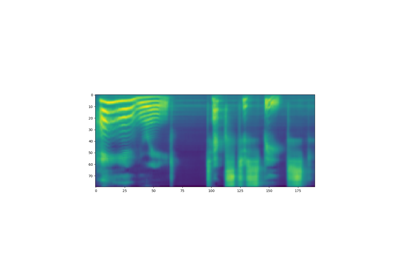Tacotron2TTSBundle
- class torchaudio.pipelines.Tacotron2TTSBundle[source]
Data class that bundles associated information to use pretrained Tacotron2 and vocoder.
This class provides interfaces for instantiating the pretrained model along with the information necessary to retrieve pretrained weights and additional data to be used with the model.
Torchaudio library instantiates objects of this class, each of which represents a different pretrained model. Client code should access pretrained models via these instances.
Please see below for the usage and the available values.
- Example - Character-based TTS pipeline with Tacotron2 and WaveRNN
>>> import torchaudio >>> >>> text = "Hello, T T S !" >>> bundle = torchaudio.pipelines.TACOTRON2_WAVERNN_CHAR_LJSPEECH >>> >>> # Build processor, Tacotron2 and WaveRNN model >>> processor = bundle.get_text_processor() >>> tacotron2 = bundle.get_tacotron2() Downloading: 100%|███████████████████████████████| 107M/107M [00:01<00:00, 87.9MB/s] >>> vocoder = bundle.get_vocoder() Downloading: 100%|███████████████████████████████| 16.7M/16.7M [00:00<00:00, 78.1MB/s] >>> >>> # Encode text >>> input, lengths = processor(text) >>> >>> # Generate (mel-scale) spectrogram >>> specgram, lengths, _ = tacotron2.infer(input, lengths) >>> >>> # Convert spectrogram to waveform >>> waveforms, lengths = vocoder(specgram, lengths) >>> >>> torchaudio.save('hello-tts.wav', waveforms, vocoder.sample_rate)
- Example - Phoneme-based TTS pipeline with Tacotron2 and WaveRNN
>>> >>> # Note: >>> # This bundle uses pre-trained DeepPhonemizer as >>> # the text pre-processor. >>> # Please install deep-phonemizer. >>> # See https://github.com/as-ideas/DeepPhonemizer >>> # The pretrained weight is automatically downloaded. >>> >>> import torchaudio >>> >>> text = "Hello, TTS!" >>> bundle = torchaudio.pipelines.TACOTRON2_WAVERNN_PHONE_LJSPEECH >>> >>> # Build processor, Tacotron2 and WaveRNN model >>> processor = bundle.get_text_processor() Downloading: 100%|███████████████████████████████| 63.6M/63.6M [00:04<00:00, 15.3MB/s] >>> tacotron2 = bundle.get_tacotron2() Downloading: 100%|███████████████████████████████| 107M/107M [00:01<00:00, 87.9MB/s] >>> vocoder = bundle.get_vocoder() Downloading: 100%|███████████████████████████████| 16.7M/16.7M [00:00<00:00, 78.1MB/s] >>> >>> # Encode text >>> input, lengths = processor(text) >>> >>> # Generate (mel-scale) spectrogram >>> specgram, lengths, _ = tacotron2.infer(input, lengths) >>> >>> # Convert spectrogram to waveform >>> waveforms, lengths = vocoder(specgram, lengths) >>> >>> torchaudio.save('hello-tts.wav', waveforms, vocoder.sample_rate)
- Tutorials using
Tacotron2TTSBundle:
get_tacotron2
- abstract Tacotron2TTSBundle.get_tacotron2(*, dl_kwargs=None) Tacotron2[source]
Create a Tacotron2 model with pre-trained weight.
- Parameters:
dl_kwargs (dictionary of keyword arguments) – Passed to
torch.hub.load_state_dict_from_url().- Returns:
The resulting model.
- Return type:
get_text_processor
- abstract Tacotron2TTSBundle.get_text_processor(*, dl_kwargs=None) TextProcessor[source]
Create a text processor
For character-based pipeline, this processor splits the input text by character. For phoneme-based pipeline, this processor converts the input text (grapheme) to phonemes.
If a pre-trained weight file is necessary,
torch.hub.download_url_to_file()is used to downloaded it.- Parameters:
dl_kwargs (dictionary of keyword arguments,) – Passed to
torch.hub.download_url_to_file().- Returns:
A callable which takes a string or a list of strings as input and returns Tensor of encoded texts and Tensor of valid lengths. The object also has
tokensproperty, which allows to recover the tokenized form.- Return type:
- Example - Character-based
>>> text = [ >>> "Hello World!", >>> "Text-to-speech!", >>> ] >>> bundle = torchaudio.pipelines.TACOTRON2_WAVERNN_CHAR_LJSPEECH >>> processor = bundle.get_text_processor() >>> input, lengths = processor(text) >>> >>> print(input) tensor([[19, 16, 23, 23, 26, 11, 34, 26, 29, 23, 15, 2, 0, 0, 0], [31, 16, 35, 31, 1, 31, 26, 1, 30, 27, 16, 16, 14, 19, 2]], dtype=torch.int32) >>> >>> print(lengths) tensor([12, 15], dtype=torch.int32) >>> >>> print([processor.tokens[i] for i in input[0, :lengths[0]]]) ['h', 'e', 'l', 'l', 'o', ' ', 'w', 'o', 'r', 'l', 'd', '!'] >>> print([processor.tokens[i] for i in input[1, :lengths[1]]]) ['t', 'e', 'x', 't', '-', 't', 'o', '-', 's', 'p', 'e', 'e', 'c', 'h', '!']
- Example - Phoneme-based
>>> text = [ >>> "Hello, T T S !", >>> "Text-to-speech!", >>> ] >>> bundle = torchaudio.pipelines.TACOTRON2_WAVERNN_PHONE_LJSPEECH >>> processor = bundle.get_text_processor() Downloading: 100%|███████████████████████████████| 63.6M/63.6M [00:04<00:00, 15.3MB/s] >>> input, lengths = processor(text) >>> >>> print(input) tensor([[54, 20, 65, 69, 11, 92, 44, 65, 38, 2, 0, 0, 0, 0], [81, 40, 64, 79, 81, 1, 81, 20, 1, 79, 77, 59, 37, 2]], dtype=torch.int32) >>> >>> print(lengths) tensor([10, 14], dtype=torch.int32) >>> >>> print([processor.tokens[i] for i in input[0]]) ['HH', 'AH', 'L', 'OW', ' ', 'W', 'ER', 'L', 'D', '!', '_', '_', '_', '_'] >>> print([processor.tokens[i] for i in input[1]]) ['T', 'EH', 'K', 'S', 'T', '-', 'T', 'AH', '-', 'S', 'P', 'IY', 'CH', '!']
get_vocoder
- abstract Tacotron2TTSBundle.get_vocoder(*, dl_kwargs=None) Vocoder[source]
Create a vocoder module, based off of either WaveRNN or GriffinLim.
If a pre-trained weight file is necessary,
torch.hub.load_state_dict_from_url()is used to downloaded it.- Parameters:
dl_kwargs (dictionary of keyword arguments) – Passed to
torch.hub.load_state_dict_from_url().- Returns:
A vocoder module, which takes spectrogram Tensor and an optional length Tensor, then returns resulting waveform Tensor and an optional length Tensor.
- Return type:

